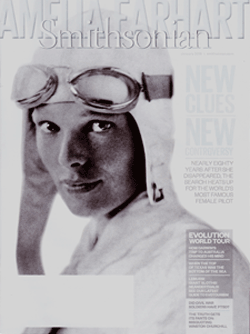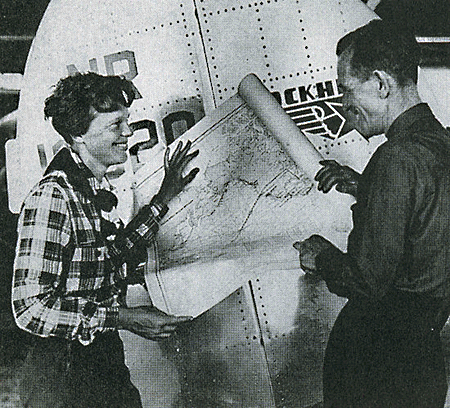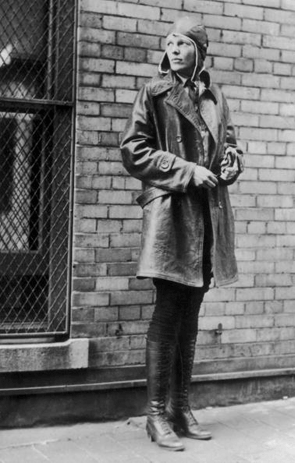| 
I can remember,
when I was very little, paging through one of the airport books my father
had written and seeing a picture of a young woman standing next to a small
airplane. I think I noticed her because, like me, she had very short hair—at
the time, my older brother and I received our haircuts from our father’s
barber, so my hair never grew past my ears. She was tall and lithe, possessing
a gamine beauty I found enthrallingly relatable. I liked her smart bomber
hat with its insectile goggles, her unruly, moppish hair, the ease in
which she existed in a tight, cropped leather jacket and buoyant riding
pants. There is a relaxed confidence and serenity in pictures of Amelia
Earhart. For someone with everything to prove, she projects an air of
having absolutely nothing to prove at all.
 The cover of the January issue of Smithsonian
Magazine features a gorgeously monochrome Amelia Earhart, and boasts
“New Clues, New Controversy” regarding her disappearance.
Again, Amelia appears calmly angelic in whitewashed tones of cream and
grey and charcoal, and I can’t help but wonder if our fascination
with her isn’t simply because she was the first woman aviator to
fly solo across the Atlantic, but because every portrait of her projects
a dreamy, subdued quality, as if we’re catching someone not meant
to be frozen in film. Her knowing look beguiles us. I challenge anyone
to look at her picture and not read a chilling intelligence and sadness
in those eyes—she looks as if she knew what was coming.
The cover of the January issue of Smithsonian
Magazine features a gorgeously monochrome Amelia Earhart, and boasts
“New Clues, New Controversy” regarding her disappearance.
Again, Amelia appears calmly angelic in whitewashed tones of cream and
grey and charcoal, and I can’t help but wonder if our fascination
with her isn’t simply because she was the first woman aviator to
fly solo across the Atlantic, but because every portrait of her projects
a dreamy, subdued quality, as if we’re catching someone not meant
to be frozen in film. Her knowing look beguiles us. I challenge anyone
to look at her picture and not read a chilling intelligence and sadness
in those eyes—she looks as if she knew what was coming.
The Smithsonian article vacillates between
the believable and the utterly fantastic. A man named Ric Gillespie harbors
a sheet of aluminum he claims originated from Earhart’s Lockheed
Electra. The sheet was found in 1991 on Gardner Island in the Pacific
Ocean, and Ric and his wife, who founded TIGHAR (The International Group
for Historic Aircraft Recovery) are convinced it belongs to Earhart’s
Lockheed Electra—a replacement piece for a window in the right rear
fuselage. They believe Earhart and her navigator, Fred Noonan, crash-landed
on Gardner Island. The only problem with this narrative is that, according
to Smithsonian Magazine, “Navy planes searched the four-mile-long
Gardner Island on July 9 without seeing Earhart.” Still, Ric Gillespie’s
theory would fall under the ‘believable’ category.
 Other, less savory, theories abound.
Other, less savory, theories abound.
A retired Pan Am navigator named Paul Rafford
Jr., author of Amelia Earhart’s Radio, believes Earhart
was working for the U.S. government (specifically, the Navy) and purposefully
got lost so that the Navy would have an excuse to search the Pacific without
raising any eyebrows amid the rising tensions there. There are other theories
that involve Japan. According to Smithsonian Magazine, “In
July 1944, Army Sgt. Thomas E. Devine arrived on the just-liberated island
of Saipan. At the airfield, he met some Marines guarding a closed hangar
they said contained Earhart’s plane.” Sgt. Devine claims he
later saw the Electra fly over the island, and that it was later “destroyed
by U.S. soldiers.” He believes “Earhart and Noonan flew there
by mistake, were captured, imprisoned and executed as spies.”
There are a few theories that involve Earhart
and Noonan’s being captured: “after failing to make landfall
at Howland, [they would have] turned northwest” and crashed “760
miles away in the Japanese-held Marshall Islands.” The theory has
been accepted as fact in the Marshall Islands: in 1987, the Marshall Islands
issued a set of stamps detailing her flight and crash-landing at Mili
Atoll. Sgt. Devine’s theory was picked up by Mike Campbell, who
wrote Amelia Earhart: The Truth At Last.  Campbell
believes Earhart and Noonan landed in the Marshalls in 1937 and were taken
to Saipan, where they were likely executed as spies. He also believes
we’ve all been fed a pack of lies in order to protect the reputation
of Franklin Delano Roosevelt, who knew where Earhart was “but didn’t
want to risk a confrontation with Japan.” In an email to Smithsonian
Magazine, Campbell wrote, “Roosevelt could never have survived
public knowledge that he failed to help America’s No. 1 aviatrix
of the Golden Age of Aviation.” Campbell
believes Earhart and Noonan landed in the Marshalls in 1937 and were taken
to Saipan, where they were likely executed as spies. He also believes
we’ve all been fed a pack of lies in order to protect the reputation
of Franklin Delano Roosevelt, who knew where Earhart was “but didn’t
want to risk a confrontation with Japan.” In an email to Smithsonian
Magazine, Campbell wrote, “Roosevelt could never have survived
public knowledge that he failed to help America’s No. 1 aviatrix
of the Golden Age of Aviation.”
Whatever happened to Amelia Earhart, our
fascination with her disappearance continues. For Dorothy Cochrane, a
curator at the Smithsonian’s National Air and Space Museum, the
obsession is enough to drive a person mad. “Now that she’s
long gone, why are people holding on to this?” she asked Smithsonian
Magazine.
I can’t speak for all the treasure
hunters, conspiracy theorists, historians, and others interested in finding
Amelia, but for myself, there is something almost unnatural in how naturally
she vanished. One of the most bizarre theories about her disappearance
assumes that she survived the war and lived out the rest of her days as
a woman in New Jersey named Irene Bolam. We seem to want to revive her
in some way—she survived, and lived fully in New Jersey; she was
forgotten by one of our most beloved Presidents, and perhaps if we debase
him, we can exhume her; she slipped away into the Pacific Ocean, and if
we reach deep enough we might raise her up from the watery depths of obscurity.
 For
as long as I can remember, when the night gets very deep and dark, and
the lights have been turned down in our home in Queens, and a fire in
the hearth sends the scent of earthy wood careening across Cunningham
Park, adjacent to our home, my father will put on Joni Mitchell’s
watery dreamscape, “Amelia.” It’s a song that sounds
like flying—it’s full of the hollow airiness of sound that
accompanies flight, the soporific din of air passing over fuselage. But
it also feels aqueous, as if Mitchell recorded it under water, or at least
sang it while bobbing over passive waves at sea. Wherever Amelia Earhart
may be, I take comfort in how much of her I find in that song, and those
lyrics. She may elude us in every picture, but she can still be found
in certain small spaces, if we look hard. For
as long as I can remember, when the night gets very deep and dark, and
the lights have been turned down in our home in Queens, and a fire in
the hearth sends the scent of earthy wood careening across Cunningham
Park, adjacent to our home, my father will put on Joni Mitchell’s
watery dreamscape, “Amelia.” It’s a song that sounds
like flying—it’s full of the hollow airiness of sound that
accompanies flight, the soporific din of air passing over fuselage. But
it also feels aqueous, as if Mitchell recorded it under water, or at least
sang it while bobbing over passive waves at sea. Wherever Amelia Earhart
may be, I take comfort in how much of her I find in that song, and those
lyrics. She may elude us in every picture, but she can still be found
in certain small spaces, if we look hard.
“A
ghost of aviation
She
was swallowed by the sky
Or
by the sea, like me she had a dream to fly
Like
Icarus ascending
On
beautiful foolish arms
Amelia,
it was just a false alarm.”
 |
|





